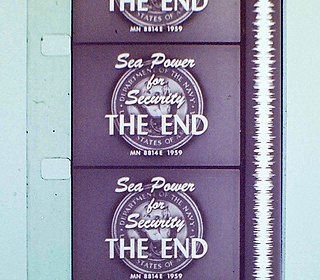
A soundtrack is a recorded audio signal accompanying and synchronised to the images of a book, drama, motion picture, radio program, television program, or video game; colloquially, a commercially released soundtrack album of music as featured in the soundtrack of a film, video, or television presentation; or the physical area of a film that contains the synchronised recorded sound.

Chiptune, also called 8-bit music, is a style of electronic music made using the programmable sound generator (PSG) sound chips or synthesizers in vintage arcade machines, computers and video game consoles. The term is commonly used to refer to tracker format music using extremely basic and small samples that an old computer or console could produce, as well as music that combines PSG sounds with modern musical styles. It has been described as "an interpretation of many genres" since any existing song can be arranged in a chiptune style defined more by choice of instrument and timbre than specific style elements.

The kazoo is a musical instrument that adds a "buzzing" timbral quality to a player's voice when the player vocalizes into it. It is a type of mirliton, one of a class of instruments which modifies its player's voice by way of a vibrating membrane of goldbeater's skin or material with similar characteristics. There is a smaller version of the kazoo, known as a humazoo.
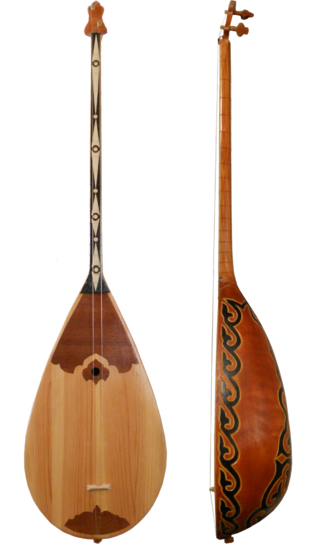
The dombra, also known as dombyra, is a long-necked musical string instrument used by the Kazakhs, Hazaras, Uzbeks, Tajiks, Nogais, Bashkirs, and Tatars in their traditional folk music. The dombra shares certain characteristics with the komuz and dutar instruments, such as its long, thin neck and oblong body shape. It is a popular instrument mostly among Turkic communities in Central Asian countries.
The Portable Sound Format (PSF) is a music file format ripped directly from video games from a variety of video game consoles. The format was originally used for PlayStation video games, but has since been adapted to support other systems.
Video game music (VGM) is the soundtrack that accompanies video games. Early video game music was once limited to sounds of early sound chips, such as programmable sound generators (PSG) or FM synthesis chips. These limitations have led to the style of music known as chiptune, which became the sound of the first video games.

The khol is a terracotta two-sided drum used in northern and eastern India for accompaniment with devotional music (bhakti). It is also known as a mridanga, not to be confused with mridangam. It originates from the Indian states of Odisha, West Bengal, Assam and Manipur. The drum is played with palms and fingers of both hands.

The morsing is an instrument similar to the Jew's harp, mainly used in Rajasthan, in the Carnatic music of South India, and in Sindh, Pakistan. It can be categorized under lamellophones, which is a sub-category of plucked idiophones. The instrument consists of a metal ring in the shape of a horseshoe with two parallel forks which form the frame, and a metal tongue in the middle, between the forks, fixed to the ring at one end and free to vibrate at the other. The metal tongue, also called the trigger, is bent at the free end in a plane perpendicular to the circular ring so that it can be struck and made to vibrate.
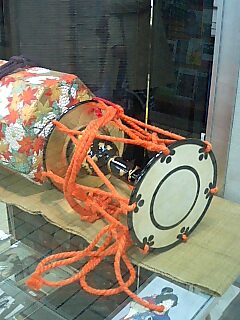
The tsudzumi (鼓) or tsuzumi is a hand drum of Japanese origin. It consists of a wooden body shaped like an hourglass, and it is taut, with two drum heads with cords that can be squeezed or released to increase or decrease the tension of the heads respectively. This mechanism allows the player to raise or lower the pitch of the drum while playing, not unlike the African talking drum and the Indian dhadd.

The Halo 2 Original Soundtrack is the soundtrack for Bungie's 2004 video game Halo 2. The soundtrack was released as two separate volumes, released almost two years apart. Volume 1, released at the same time as Halo 2 on November 9, 2004, contains arranged instrumental pieces written by Martin O'Donnell and his partner Michael Salvatori, as well as "inspired-by" tracks from bands Incubus, Hoobastank and Breaking Benjamin. Volume 2 was released on April 25, 2006, and contains all the game music arranged in a suite form.
In animation and film, "Mickey Mousing" is a film technique that syncs the accompanying music with the actions on screen, "Matching movement to music", or "The exact segmentation of the music analogue to the picture." The term comes from the early and mid-production Walt Disney films, where the music almost completely works to mimic the animated motions of the characters. Mickey Mousing may use music to "reinforce an action by mimicking its rhythm exactly. ... Frequently used in the 1930s and 1940s, especially by Max Steiner, it is somewhat out of favor today, at least in serious films, because of overuse. However, it can still be effective if used imaginatively". Mickey Mousing and synchronicity help structure the viewing experience, to indicate how much events should impact the viewer, and to provide information not present on screen. The technique "enable[s] the music to be seen to 'participate' in the action and for it to be quickly and formatively interpreted ... and [to] also intensify the experience of the scene for the spectator." Mickey Mousing may also create unintentional humor, and be used in parody or self-reference.

The bombard is a contemporary family of oboes widely used to play traditional Breton music, where it is considered emblematic. A bombard player is known as a talabarder.

This Binary Universe is the fifth studio album by the composer and electronica artist BT. It was released on August 29, 2006. The album was a significant about-face for Transeau, largely abandoning the progressive trance music he was known for, in favor of ambient soundscapes, live orchestration and glitch music. It is the first BT album not to be released on vinyl, nor feature any singles. The album was also composed specifically for DTS 5.1 surround sound. A film version of the album received a limited theatrical run, usually accompanied by appearances by Transeau himself. The album is dedicated to Transeau's daughter, Kaia. The album's artwork makes nods to binary by spelling BT's name in morse code on the cover, as well as using additional morse code on the DVD menus.
The cuatro is a family of Latin American string instruments played in Colombia, Puerto Rico, Venezuela and other Latin American countries. It is derived from the Spanish guitar. Although some have viola-like shapes, most cuatros resemble a small to mid-sized classical guitar. In Puerto Rico and Venezuela, the cuatro is an ensemble instrument for secular and religious music, and is played at parties and traditional gatherings.

Guitarist is a British monthly music-making magazine published by Future plc. First published in 1984, It is the longest-established European guitar-player magazine, and is currently the biggest-selling guitar magazine in the UK. The current editor Jamie Dickson, has had the position since late 2013. Each issue covers three areas: reviews, interview and technique. This may include reviews of newly released guitars, amplifiers and other equipment; interviews with famous and up-and-coming guitar players; and features on the guitar industry, news articles, playing technique with tablature. Guitarist's slogan was previously "The Guitar Player's Bible", before changing in 2012 to "The Guitar Magazine".
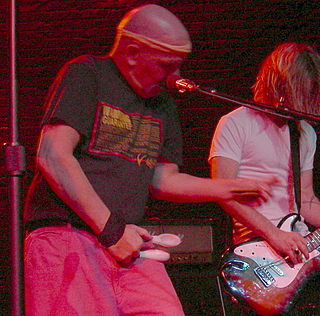
Spoons can be played as a makeshift percussion instrument, or more specifically, an idiophone related to the castanets. They are played by hitting one spoon against the other.
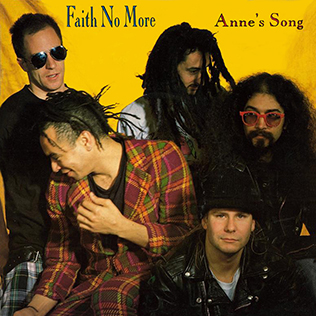
"Anne's Song" is a 1988 single by American band Faith No More, taken from their 1987 album Introduce Yourself. Written by band members Billy Gould and Roddy Bottum, the song describes an acquaintance of theirs from New York, and her circle of friends. The single was produced by Matt Wallace and Steve Berlin and released by Slash Records.

"The Sound Above My Hair" is the third single release from the Scooter album Under the Radar Over the Top, following "J'adore Hardcore" and "Ti sento". "The Sound Above My Hair" was first performed live at The Dome 52. The track used in the single was taken from a sample of "Wonderful Life" by the English alternative rock band Black. In addition, the track also samples the 19th century Shaker hymn, "Simple Gifts". H. P. Baxxter uses Auto-Tune effect while singing.

"Dreamers" is the sixth official single taken from English hip hop duo Rizzle Kicks' debut studio album, Stereo Typical. The single was released in the United Kingdom on 3 August 2012. The track was produced by Ant Whiting. The song features a sample from Nirvana's 1968 single Rainbow Chaser. A music video to accompany the release of "Dreamers" was uploaded to YouTube on 25 July 2012, at a total length of four minutes and forty-two seconds. It was directed and filmed by Toby Lockerbie. The video features footage of the duo partying on a desert island with a group of friends. Dappy makes a cameo appearance in the video.
The music for the 2011 neo-noir detective video game L.A. Noire, developed by Team Bondi and published by Rockstar Games, was composed by musicians Andrew Hale and Simon Hale. Recorded at Abbey Road Studios in London, the score also features contributions from Woody Jackson, who had collaborated with Rockstar on other projects both previously and since. Andrew Hale felt that composing the game's score was about setting a mood, attempting to compose music that felt accessible to players. The score was inspired by films from the 1940s, though the team avoided specifically composing for this time period, instead opting to focus on that after the music had been produced. Three supplementary vocal recordings were composed by The Real Tuesday Weld and performed by Claudia Brücken; they also sought to fit with the game's setting.














